Even in normal conditions, the river lapped at the foundations of the stores on the west side of Main St. (at low tide you could see the sewage outlets) and the town used the marsh on the river edge of Jessup Green as a landfill/garbage dump. Flocks of squawking gulls circled the dump and sat on the Post Road bridge railings.
Westport straddles the Saugatuck River, a tidal river that runs from the Long Island Sound to Nash's Pond, at the north end of the town. When I lived on the banks of the Saugatuck, it was an open sewer and all the awful offal flowed down to the Sound with each outgoing tide. At low tide, the mud flats stunk and we often saw interesting artifacts flowing past our dock. We often had flood tides in late fall when the moon was full and especially if there had been a hurricane. Riverside Ave. would be flooded. The river came through our seawall, sometimes submerging it entirely, and rose up across our lawn to crest at the edge of our terrace. Our house was never threatened. And, if the weather was not too bad, we were allowed to don boots and slosh around our front yard.
We often had flood tides in late fall when the moon was full and especially if there had been a hurricane. Riverside Ave. would be flooded. The river came through our seawall, sometimes submerging it entirely, and rose up across our lawn to crest at the edge of our terrace. Our house was never threatened. And, if the weather was not too bad, we were allowed to don boots and slosh around our front yard.
In time, the river was filled in behind the stores, and parking space created. A band shell was erected over the site of the Westport dump, and later the library was built in that spot.
Cross over the Post Road Bridge in the direction of Norwalk, and take the first street on the left. This is Riverside Ave. and follows the river all the way to the Saugatuck Station.
Halfway to the station stands the building that was Staples High School when we lived there. We graduated from that building in 1952 and 1954. Behind it, across the playing fields, stood the building that at that time was Bedford Junior High, and we both put in our time there, too.
Across the street from Staples was a Salvage Barn - used during WWII for scrap and newspaper drives - and across the river from the Salvage Barn was the house in which I was raised.
In my senior year, 1952, the school theatrical cub -- the "Masque and Wig Club" put on the play "Years Ago" in the school gymnasium/lunchroom. It was theater in the round. My best friend Ruth Esther and I were the sound crew, and the lighting crew - pulled from the lower classes - included a funny, red headed guy by the name of Larry Comden. I was impressed with his sense of humor. He was impressed with my car (and a few other things).
I had a good time in high school, which I never took very seriously. I had a few good friends and one very fine boyfriend (unappreciated at the time).
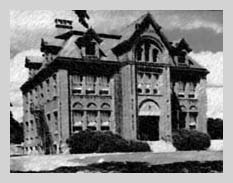 The original Staples building - which we called the "Old Building" was built by Horace Staples in 1885, and he left a stipend in his will that would provide for its upkeep for as long as the building should stand. By the time I arrived, it was 65 years young and the business and shop classes were held there. The Band Room was also in the Old Building. The college core classes were taught in the new building.
The original Staples building - which we called the "Old Building" was built by Horace Staples in 1885, and he left a stipend in his will that would provide for its upkeep for as long as the building should stand. By the time I arrived, it was 65 years young and the business and shop classes were held there. The Band Room was also in the Old Building. The college core classes were taught in the new building.
My parents were appalled when I signed up for typing in the Old Building, but it turned out to be one of the most valuable courses I ever took and gave me a skill that I use today.
By contrast, I have not used Algebra once since I left school. And geometry? Maybe half a dozen times.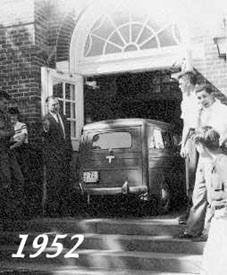 Here is a picture of that impressive car, a '49 Crosley, light and tinny and could easily be picked up by 4 strong boys. Our principal, Mr. Young, is questioning this group of disinterested but strong boys about whether they knew anything about the appearance of a small car in the school hallway.
Here is a picture of that impressive car, a '49 Crosley, light and tinny and could easily be picked up by 4 strong boys. Our principal, Mr. Young, is questioning this group of disinterested but strong boys about whether they knew anything about the appearance of a small car in the school hallway.
The school was located exactly across the Saugatuck River from my home. Until I got the Crosley, in my junior year, I either took the bus to school, or walked. Or rowed.
Yes, my sister and I were the only students who occasionaly came to school by boat. We'd row across the rive, stow the boat in the salvage barn and walk across the street to school.
We are heading to the heart of Saugatuck, a neighborhood settled by Italian families - men who had come over to build the railroad, and stayed to settle down here.
They all came from Calabria, a region in Italy where St. Anthony of Padua was celebrated as the patron saint, and St. Anthony's day was an important festival in Saugatuck. The actual date for St. Anthony's Day is June 13, but I remember it as encompassing an entire weekend. St. Anthony's day included a parade, a street fair, and fireworks. The parade started at St. Anthony's Hall, not far from the RR station, and marched down Riverside Ave. to the Catholic Church just beyond the high school. We'd watch the parade from our "grand stand" seats on our dock.
And then in the evening we'd go to the fair - which encircled the park in Saugatuck and featured an oompah band and games and food booths. Oh, the smell of onion, peppers and sausages! I may have been a little tow headed WASP, but my taste buds were Italian.
Was it at St. Anthony's, or at the Arrow Restaurant that I had my first taste of pizza? The Arrow was on the second floor of an arrow shaped building at the corner of Ketchum and Franklin Streets, and if I didn't have my first taste of pizza there I certainly had my 4th and 5th and 50th.
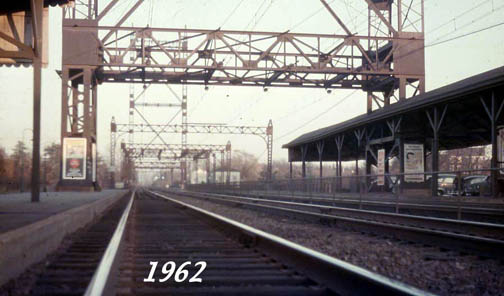
At the end of Riverside Ave. is the railroad station. Many, if not most, of Westport's fathers commuted to New York City from this station. The New York, New Haven and Hartford RR had - and still has - regular commuting trains running in both directions.
My father commuted from 1940 until the early '60s when ill health forced his retirement. He caught a NY bound train at 7:30 in the morning, and returned to the Saugatuck Station at 7:30 at night.
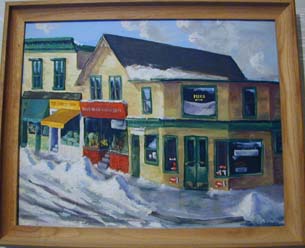 There are a line of shops across from the railroad station, most catering to the commuters. On the corner stood Baer's candy/newspaper shop. Next to Baer's, the Black Horse Liquor Store, an important commodity in Westport. Next, George Comden's Cheese Shop. Good to have cheese to nibble along with your cocktails.
Then, Mrs. Salvo's tailoring shop. She may have also taken in clothes for a dry cleaner, but my memories are of her sitting in her window, sewing. Then, Jimmy's Shoe Repair shop. Beyond Jimmy's, a coffee shop where the commuters could slurp down coffee and crullers while waiting for the train. Madeline was the waitress there and she was legendary - she knew her customers and would have a commuter's order sitting on the counter by the time he sat down.
There are a line of shops across from the railroad station, most catering to the commuters. On the corner stood Baer's candy/newspaper shop. Next to Baer's, the Black Horse Liquor Store, an important commodity in Westport. Next, George Comden's Cheese Shop. Good to have cheese to nibble along with your cocktails.
Then, Mrs. Salvo's tailoring shop. She may have also taken in clothes for a dry cleaner, but my memories are of her sitting in her window, sewing. Then, Jimmy's Shoe Repair shop. Beyond Jimmy's, a coffee shop where the commuters could slurp down coffee and crullers while waiting for the train. Madeline was the waitress there and she was legendary - she knew her customers and would have a commuter's order sitting on the counter by the time he sat down.
There was a restaurant, Mario's, that is still there today. Several other stores and the block ended with the Westport Feed and Grain.
The two streets parallel to Riverside Ave are Ketchum St. and Franklin Ave. When Larry was in college, and I was working in the Cheese Shop with a wee toddler of our own, we lived at 1 Franklin St. in a cottage that had been hand built by the Capriola brothers. It was small, and all the rooms were irregular - a bedroom, a sitting room and a long skinny kitchen. A small sun porch was used as the baby's room, and the bathroom with shower was tacked on almost as an afterthought. I loved it dearly, and adored Mr. Capriola, who often gave us produce from his extensive garden in back. He also made wine, which he aged in the cellar beneath our cottage.

We leave Saugatuck at Bridge St. There once was a coffin nail factory at the Saugatuck end of the bridge, and we could see the women working the coffin nail presses from our car windows as we passsed. Peter's Bridge Market was next to the coffin nail factory, sitting right at the sidewalk with parking in the back. Across from Peter's was the Bridge Garage, where my father did all his car business. My father did not mess with cars. He said, "I make good money at what I do well so I can pay someone to fix my car, who does that well." Gasoline was 25¢ a gallon in those days and when I had my Crosley, I'd get a gallon each morning on my way to school. I never got any oil, and that was the end of the Crosley.
Throughout the 19th century, the Saugatuck River was a commercial route. Onions were shipped on masted schooners from the town docks. Any bridge below the Post Road had to accommodate these vessels. The railroad bridge was a draw bridge, and the Bridge St. bridge pivoted sideways to let the boats pass. I'm sure that during the commercial heydays there was a bridgeman on duty to operate it, but when I was a child and the boats passing throught were just occasional pleasure boats, it worked like this. The boat captain would call the Coast Guard who would come to open the bridge. If they didn't have enough manpower, they would recruit able bodied men from the waiting cars! They would "wind" the bridge open using a 3' key stuck into the bridge mechanism. A handle was threaded through the top of this key, and then men would walk round and round, as the bridge swung open. Once the boat had passed through, they'd walk round and round in the other direction, until the bridge snapped shut.
In all the years I traveled Bridge St. I only saw this twice. We got out of the car and stood on the banks to watch.
Just beyond the bridge we encounter the other end of Imperial Avenue. I lived in Imperial Park, off the avenue, and attended Saugatuck School, a little farther up Bridge St. Although we did not live in the heart of the district, we thought of ourselves as "Saugatuck kids".
They decided to put me in Miss Coyle's first grade. Miss Coyle was old, older than my grandmothers. She was firm and trim and wore her white hair coiled in a little bun at her neck. I loved Miss Coyle.
Our principal was Miss Adams, who loved to recite the poem "Little Orphan Annie" at assemblies:
I walked Imperial Ave every day to get to Saugatuck School, and thought of it as a hilly avenue. Now, with years of western Pennsylvania hills under my belt, I can tell you, it is not hilly.
I came to Westport ready for first grade, after the school year had started. On my first day at the new school, I was given a psychological test to see where I would be placed. The woman who administered the test in her small office was red haired and boney faced. She showed me a picture of a man sawing wood. He had the saw upside down! How funny!
Because our homes were close, Miss Coyle assigned Susan Kimber to be my guide. We walked to and from school together and she became my best friend until Jr. High when she discovered boys and I didn't.
"Little Orphan Annie's come to our house to stay
To wash the cups and tidy up and sweep the crumbs away."
Strange poem to read to impressionable little children, and I remember it to this day.
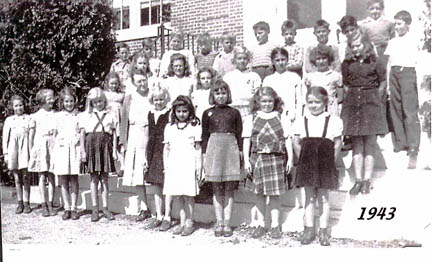
Ours was a big stone house, built on several levels into a hill that sloped down to the river. We had a dock on the river, and there was always a boat.
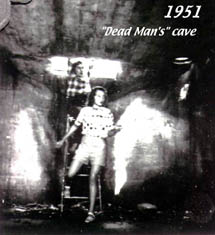 Imperial Park was carved out of the estate of a wealthy inventor in the 1930's. The sunken gardens next to Spangenberg's had been the tennis courts, Mrs. Johnson lived in the original stables and the Coopers in the gardener's cottage. The main house of the estate was a large structure made of formed cement, because the owner had become rich from the patent on earthquake proof cement.
He built a laboratory in the woods behind the house, a room made of his earthquake proof cement that was dug into the side of a hill, overlooking a tidewater pond. In our day, it was overgrown with vines and barely visible. Because the inventor had long since died, the room was called "dead mans cave" and it was the domain of the Imperial Park kids. It was a pirate's cave, a clubhouse, a hideout. During the WWII years, it was a bomb shelter in which we'd cower, pretending we were under attack.
Imperial Park was carved out of the estate of a wealthy inventor in the 1930's. The sunken gardens next to Spangenberg's had been the tennis courts, Mrs. Johnson lived in the original stables and the Coopers in the gardener's cottage. The main house of the estate was a large structure made of formed cement, because the owner had become rich from the patent on earthquake proof cement.
He built a laboratory in the woods behind the house, a room made of his earthquake proof cement that was dug into the side of a hill, overlooking a tidewater pond. In our day, it was overgrown with vines and barely visible. Because the inventor had long since died, the room was called "dead mans cave" and it was the domain of the Imperial Park kids. It was a pirate's cave, a clubhouse, a hideout. During the WWII years, it was a bomb shelter in which we'd cower, pretending we were under attack.
On the side yard we had our Victory Garden and chicken coop. During the war years we raised chickens all summer for their eggs, and each Sunday, a roast chicken for our table. By fall they were all gone and the coop closed up, to be reopened in the spring when our next Sears shipment of peeps arrived.
After the war, the chickens were no longer allowed, and the chicken house became my club house, surrounded by the most fertile garden immaginable.
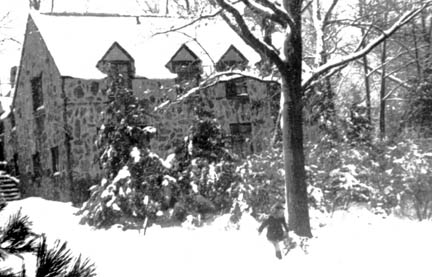
In warm weather we had a rowboat and explored the river. We learned to watch for snapping turtles and avoid the swans. We were not allowed to swim -- for fear of polio -- but we could fish and crab, using a net on a pole. The crabs grew fat on eating the garbage that floated by. We'd scoop them up into a bucket sitting on the floor of our rowboat. One time I upset the bucket. You never saw two girls move so fast, scooping the crabs back into the river while balanced on the seats of the little boat.
We played on the river banks and explored the woods. We walked or biked to friends houses. It was a safe place to grow up. My mother never worried.
The town blew the fire whistle every afternoon at 5 pm. My sister and I were allowed to go anywhere, do anything. But when the 5 o'clock whistle blew, it was time to come running home.
 Westport is built on glacial till, and any entrepreneur with a steam shovel and sifter could have built a gravel pit anywhere in Westport. The Gault Brothers chose one of the hills that line the river along Imperial Ave. and began digging away at it. It had been in operation for a generation - a scruffy area with rock heaps, piles of gravel and sand.
Westport is built on glacial till, and any entrepreneur with a steam shovel and sifter could have built a gravel pit anywhere in Westport. The Gault Brothers chose one of the hills that line the river along Imperial Ave. and began digging away at it. It had been in operation for a generation - a scruffy area with rock heaps, piles of gravel and sand.
Every winter, as long as there were Gault children of skating age (and I was lucky to have one as a classmate) the town firemen flooded a low, swampy area in the gravel pit. Within a week Mother Nature would have it frozen solid and we'd have a safe skating rink for the rest of the winter. The Imperial Ave. boys kept it cler of snow so that they could play hockey. We girls stuck to the edges where the reeds stuck through. I learned to skate at Gault's gravel pit.